weight Lexus ES300h 2018 Owner's Manual (OM33D45U)
[x] Cancel search | Manufacturer: LEXUS, Model Year: 2018, Model line: ES300h, Model: Lexus ES300h 2018Pages: 608, PDF Size: 10.67 MB
Page 35 of 608
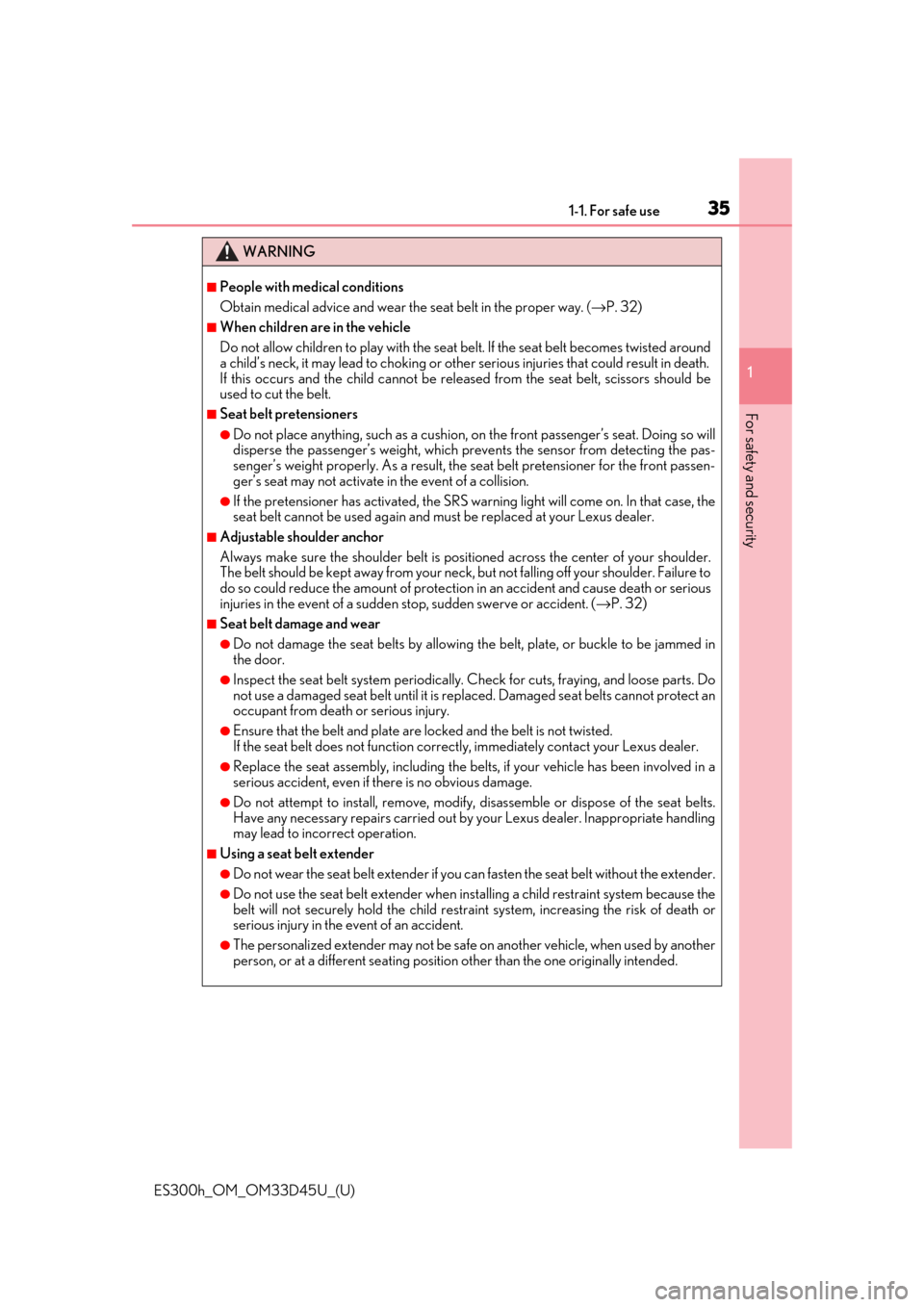
351-1. For safe use
ES300h_OM_OM33D45U_(U)
1
For safety and security
WARNING
■People with medical conditions
Obtain medical advice and wear the seat belt in the proper way. (→P. 32)
■When children are in the vehicle
Do not allow children to play with the seat belt. If the seat belt becomes twisted around
a child’s neck, it may lead to choking or othe r serious injuries that could result in death.
If this occurs and the child cannot be releas ed from the seat belt, scissors should be
used to cut the belt.
■Seat belt pretensioners
●Do not place anything, such as a cushion, on the front passenger’s seat. Doing so will
disperse the passenger’s weight, which prevents the sensor from detecting the pas-
senger’s weight properly. As a result, the seat belt pretensioner for the front passen-
ger’s seat may not activate in the event of a collision.
●If the pretensioner has activated, the SRS wa rning light will come on. In that case, the
seat belt cannot be used again and must be replaced at your Lexus dealer.
■Adjustable shoulder anchor
Always make sure the shoulder belt is posi tioned across the center of your shoulder.
The belt should be kept away from your neck , but not falling off your shoulder. Failure to
do so could reduce the amount of protection in an accident and cause death or serious
injuries in the event of a sudden stop, sudden swerve or accident. ( →P. 32)
■Seat belt damage and wear
●Do not damage the seat belts by allowing th e belt, plate, or buckle to be jammed in
the door.
●Inspect the seat belt system periodically. Check for cuts, fraying, and loose parts. Do
not use a damaged seat belt until it is replaced. Damaged seat belts cannot protect an
occupant from death or serious injury.
●Ensure that the belt and plate are locked and the belt is not twisted.
If the seat belt does not function correct ly, immediately contact your Lexus dealer.
●Replace the seat assembly, including the belts, if your vehicle has been involved in a
serious accident, even if there is no obvious damage.
●Do not attempt to install, remove, modify, disassemble or dispose of the seat belts.
Have any necessary repairs carried out by your Lexus dealer. Inappropriate handling
may lead to inco rrect operation.
■Using a seat belt extender
●Do not wear the seat belt extender if you can fasten the seat belt without the extender.
●Do not use the seat belt extender when in stalling a child restraint system because the
belt will not securely hold the child restra int system, increasing the risk of death or
serious injury in the event of an accident.
●The personalized extender may not be safe on another vehicle, when used by another
person, or at a different seating position other than the one originally intended.
Page 50 of 608

501-1. For safe use
ES300h_OM_OM33D45U_(U)
WARNING
■Front passenger occupant classification system precautions
Observe the following precautions regarding the front passenger occupant classifica-
tion system.
Failure to do so may cause death or serious injury.
●Wear the seat belt properly.
●Make sure the front passenger’s seat belt plate has not been left inserted into the
buckle before someone sits in the front passenger seat.
●Make sure the “AIR BAG OFF” indicator li ght is not illuminated when using the seat
belt extender for the front passenger seat. If the “AIR BAG OFF” indicator light is illu-
minated, disconnect the extender tongue from the seat belt buckle, and reconnect
the seat belt. Reconnect the seat belt extender after making sure the “AIR BAG ON”
indicator light is illuminated. If you use the seat belt extender while the “AIR BAG
OFF” indicator light is illuminated, the SR S airbags for front passenger will not acti-
vate, which could cause death or seriou s injury in the event of a collision.
●Do not apply a heavy load to the front passenger seat or equipment (e.g. seatback
pockets).
●Do not put weight on the front passenger seat by putting your hands or feet on the
front passenger seat seatback from the rear passenger seat.
●Do not let a rear passenger lift the front passenger seat with their feet or press on the
seatback with their legs.
●Do not put objects under the front passenger seat.
Page 118 of 608
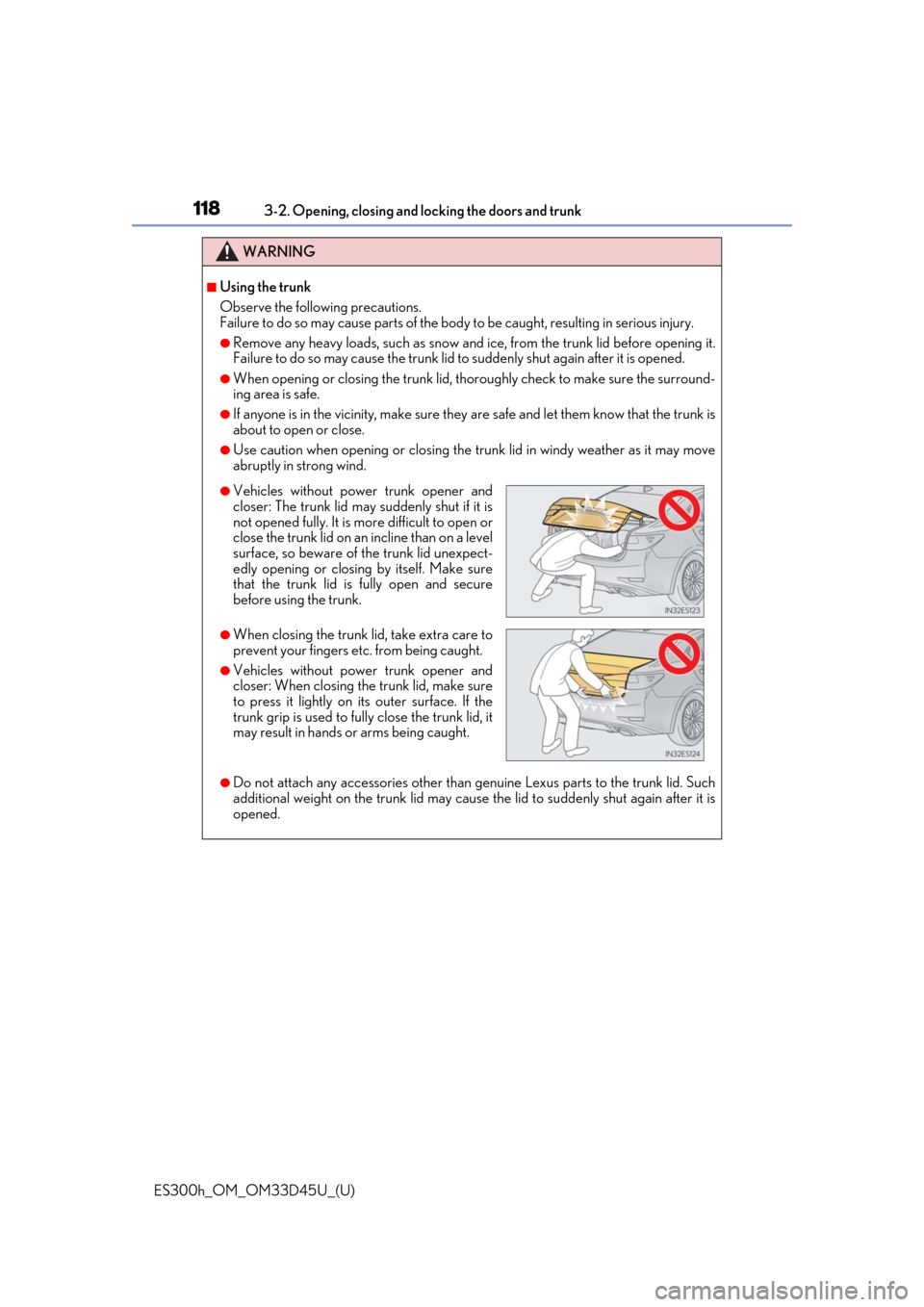
118
ES300h_OM_OM33D45U_(U)3-2. Opening, closing and
locking the doors and trunk
WARNING
■Using the trunk
Observe the following precautions.
Failure to do so may cause parts of the body to be caught, resulting in serious injury.
●Remove any heavy loads, such as snow and ice, from the trunk lid before opening it.
Failure to do so may cause the trunk lid to suddenly shut again after it is opened.
●When opening or closing the trunk lid, thoroughly check to make sure the surround-
ing area is safe.
●If anyone is in the vicinity, make sure they are safe and let them know that the trunk is
about to open or close.
●Use caution when opening or closing the tr unk lid in windy weather as it may move
abruptly in strong wind.
●Do not attach any accessories other than genuine Lexus parts to the trunk lid. Such
additional weight on the trunk lid may cause the lid to suddenly shut again after it is
opened.
●Vehicles without power trunk opener and
closer: The trunk lid may suddenly shut if it is
not opened fully. It is more difficult to open or
close the trunk lid on an incline than on a level
surface, so beware of the trunk lid unexpect-
edly opening or closin g by itself. Make sure
that the trunk lid is fully open and secure
before using the trunk.
●When closing the trunk li d, take extra care to
prevent your fingers etc. from being caught.
●Vehicles without power trunk opener and
closer: When closing the trunk lid, make sure
to press it lightly on its outer surface. If the
trunk grip is used to fully close the trunk lid, it
may result in hands or arms being caught.
Page 162 of 608

162
ES300h_OM_OM33D45U_(U)4-1. Before driving
Cargo and luggage
Cargo capacity depends on the total weight of the occupants.
(Cargo capacity) = (Total load capac
ity) — (Total weight of occupants)
Steps for Determining Correct Load Limit ⎯
(1) Locate the statement “The combined weight of occupants and cargo should
never exceed XXX kg or XXX lbs. ” on your vehicle’s placard.
(2) Determine the combined weight of th e driver and passengers that will be rid-
ing in your vehicle.
(3) Subtract the combined weight of th e driver and passengers from XXX kg or
XXX lbs.
(4) The resulting figure equals the ava ilable amount of cargo and luggage load
capacity.
For example, if the “XXX” amount equals 1400 lbs. and there will be five 150
lb passengers in your vehicle, the amou nt of available cargo and luggage load
capacity is 650 lbs. (1400 − 750 (5 × 150) = 650 lbs.)
(5) Determine the combined weight of luggage and cargo being loaded on the
vehicle. That weight may not safely exceed the available cargo and luggage
load capacity calculated in Step 4.
(6) If your vehicle will be towing a trailer, load from your trailer will be transferred
to your vehicle. Consult this manual to determine how this reduces the avail-
able cargo and luggage load capacity of your vehicle. ( →P. 165)
Lexus does not recommend towing a trailer with your vehicle. Your vehicle is not
designed for trailer towing.
Take notice of the following informat ion about storage precautions, cargo
capacity and load:
Capacity and distribution
Page 163 of 608
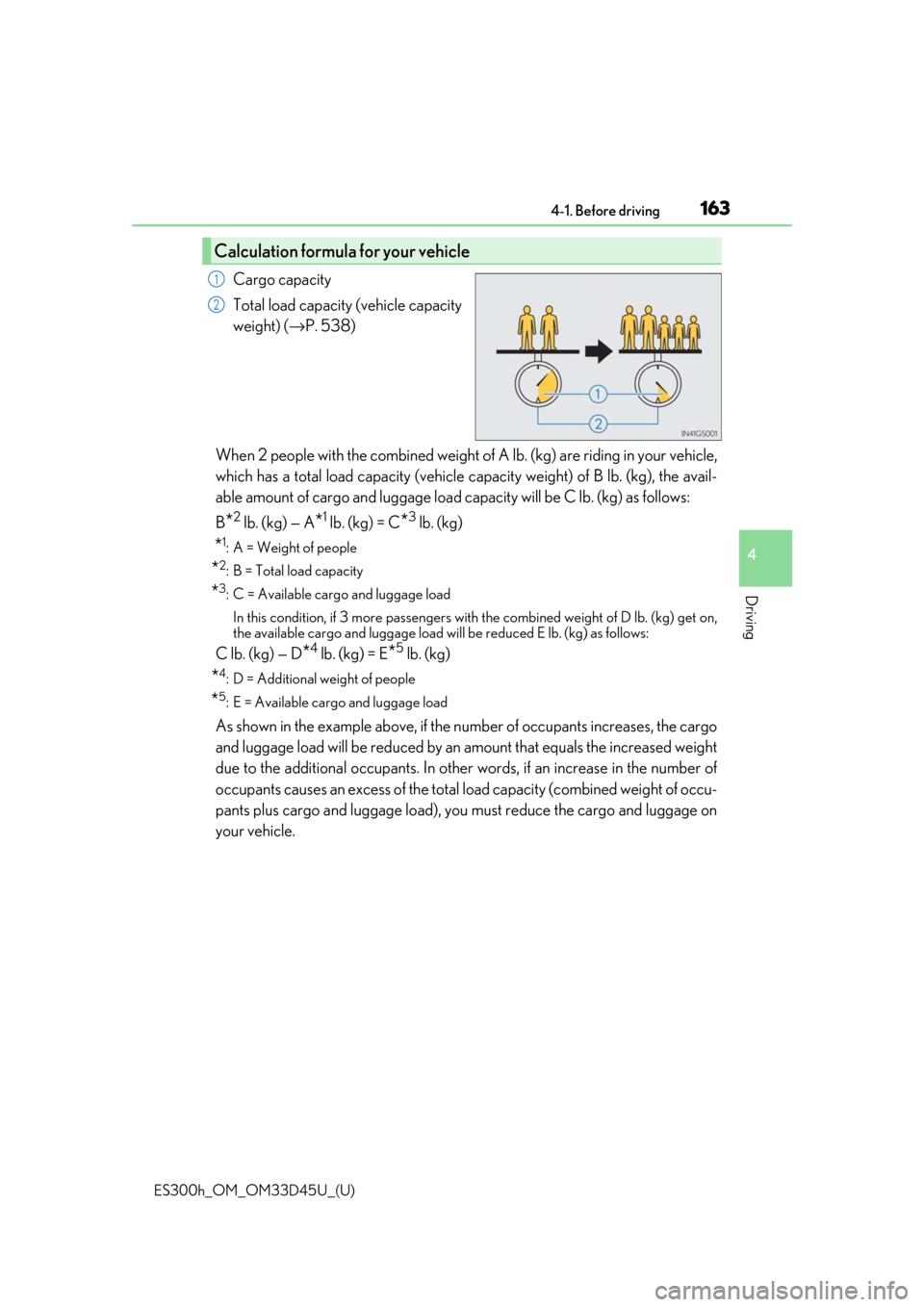
ES300h_OM_OM33D45U_(U)
1634-1. Before driving
4
Driving
Cargo capacity
Total load capacity (vehicle capacity
weight) (→P. 538)
When 2 people with the combined weight of A lb. (kg) are riding in your vehicle,
which has a total load capacity (vehicle capacity weight) of B lb. (kg), the avail-
able amount of cargo and luggage load capacity will be C lb. (kg) as follows:
B
*2 lb. (kg) — A*1 lb. (kg) = C*3 lb. (kg)
*1: A = Weight of people
*2: B = Total load capacity
*3: C = Available cargo and luggage load
In this condition, if 3 more passengers with the combined weight of D lb. (kg) get on,
the available cargo and luggage load w ill be reduced E lb. (kg) as follows:
C lb. (kg) — D*4 lb. (kg) = E*5 lb. (kg)
*4: D = Additional weight of people
*5: E = Available cargo and luggage load
As shown in the example above, if the nu mber of occupants increases, the cargo
and luggage load will be reduced by an amount that equals the increased weight
due to the additional occupants. In other words, if an increase in the number of
occupants causes an excess of the total load capacity (combined weight of occu-
pants plus cargo and luggage load), yo u must reduce the cargo and luggage on
your vehicle.
Calculation formula for your vehicle
1
2
Page 164 of 608

164
ES300h_OM_OM33D45U_(U)4-1. Before driving
WARNING
■Things that must not be carried in the trunk
The following things may cause a fire if loaded in the trunk:
●Receptacles containing gasoline
●Aerosol cans
■Storage precautions
Observe the following precautions.
Failure to do so may prevent the pedals from being depressed properly, may block the
driver’s vision, or may result in items hittin
g the driver or passengers, possibly causing
an accident.
●Stow cargo and lugg age in the trunk whenever possible.
●Do not place cargo or luggage in or on the following locations.
• At the feet of the driver
• On the front passenger or re ar seats (when stacking items)
• On the package tray
• On the instrument panel
•On the dashboard
• In front of the navigation system screen or Lexus Display Audio system screen
●Secure all items in the occupant compartment.
■Capacity and distribution
●Do not exceed the maximum axle weight rating or the total vehicle weight rating.
●Even if the total load of occupant’s weight and the cargo load is less than the total load
capacity, do not apply the load unevenly. Improper loading may cause deterioration
of steering or braking control whic h may cause death or serious injury.
Page 165 of 608
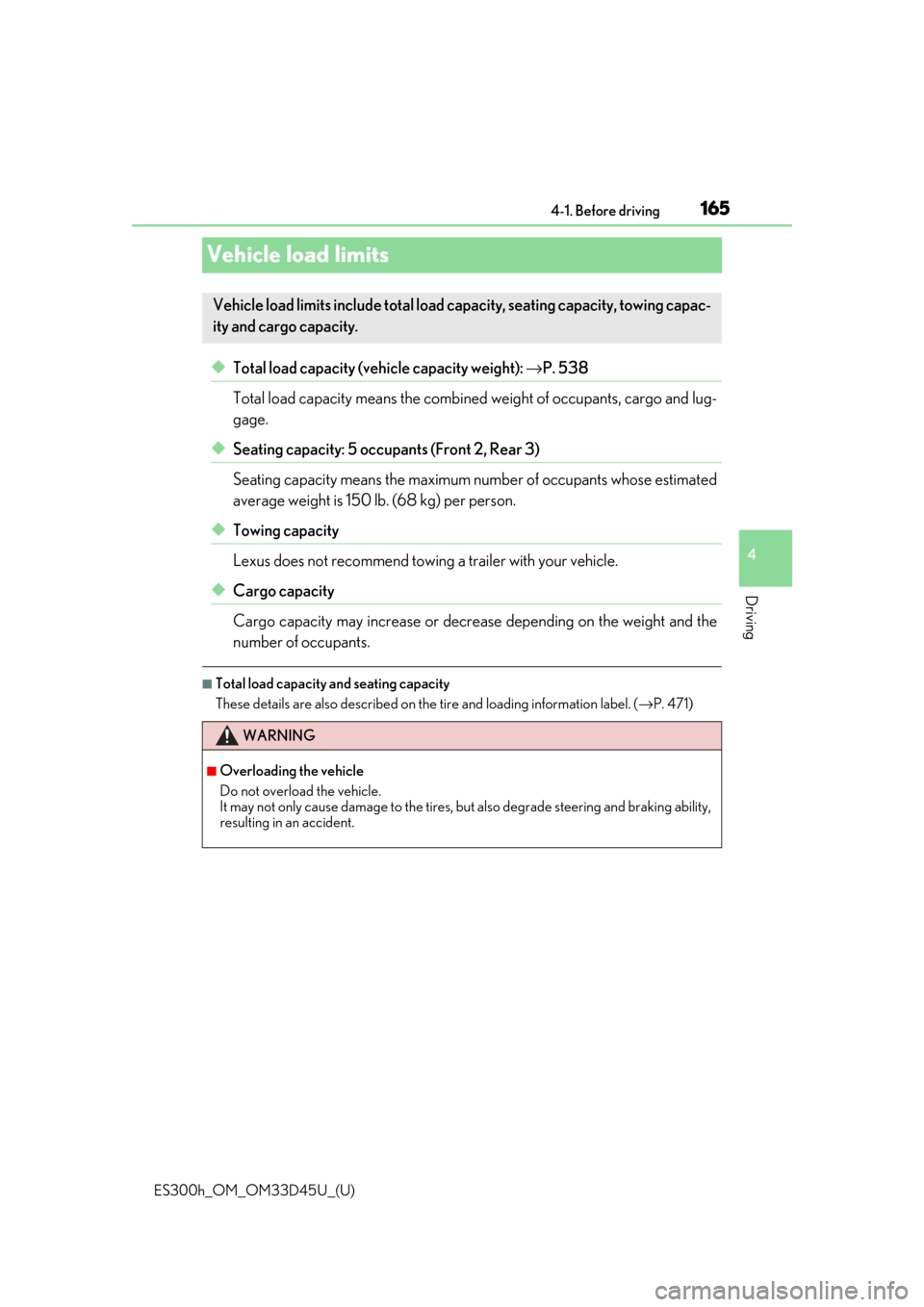
165
ES300h_OM_OM33D45U_(U)4-1. Before driving
4
Driving
Vehicle load limits
◆Total load capacity (vehicle capacity weight):
→P. 538
Total load capacity means the combined weight of occupants, cargo and lug-
gage.
◆Seating capacity: 5 occupants (Front 2, Rear 3)
Seating capacity means the maximum number of occupants whose estimated
average weight is 150 lb. (68 kg) per person.
◆Towing capacity
Lexus does not recommend towing a trailer with your vehicle.
◆Cargo capacity
Cargo capacity may increase or decrease depending on the weight and the
number of occupants.
■Total load capacity and seating capacity
These details are also described on the tire and loading information label. (→P. 471)
Vehicle load limits include total load capacity, seating capacity, towing capac-
ity and cargo capacity.
WARNING
■Overloading the vehicle
Do not overload the vehicle.
It may not only cause damage to the tires, but also degrade steering and braking ability,
resulting in an accident.
Page 462 of 608
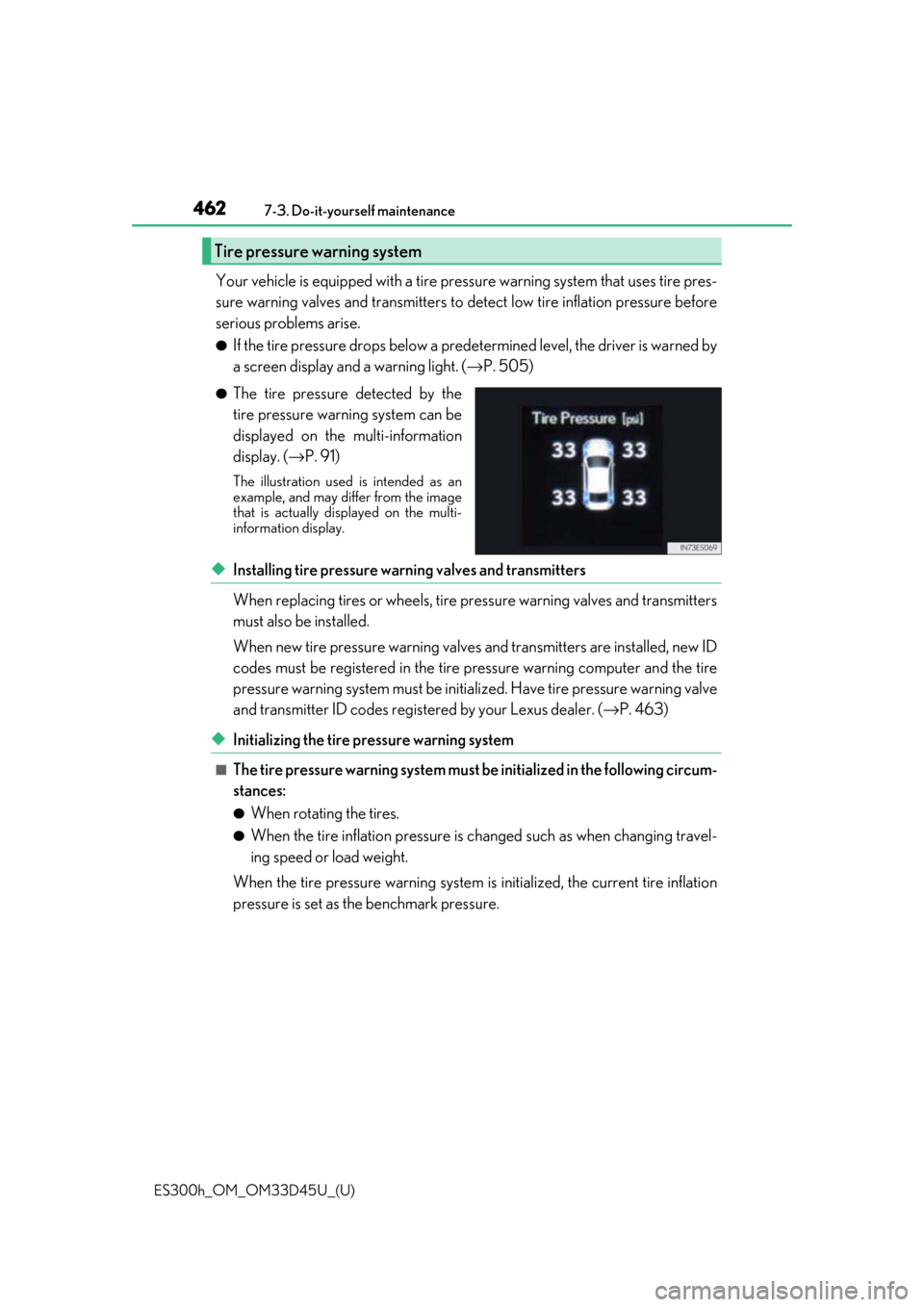
462
ES300h_OM_OM33D45U_(U)7-3. Do-it-yourself maintenance
Your vehicle is equipped with a tire pressure warning system that uses tire pres-
sure warning valves and transmitters to
detect low tire inflation pressure before
serious problems arise.
●If the tire pressure drops below a predet ermined level, the driver is warned by
a screen display and a warning light. ( →P. 505)
●The tire pressure detected by the
tire pressure warning system can be
displayed on the multi-information
display. ( →P. 91)
The illustration used is intended as an
example, and may differ from the image
that is actually disp layed on the multi-
information display.
◆Installing tire pressure warning valves and transmitters
When replacing tires or wheels, tire pr essure warning valves and transmitters
must also be installed.
When new tire pressure wa rning valves and transmitters are installed, new ID
codes must be registered in the tire pressure warning computer and the tire
pressure warning system must be initia lized. Have tire pressure warning valve
and transmitter ID codes registered by your Lexus dealer. ( →P. 463)
◆Initializing the tire pressure warning system
■The tire pressure warning system must be initialized in the following circum-
stances:
●When rotating the tires.
●When the tire inflation pressure is changed such as when changing travel-
ing speed or load weight.
When the tire pressure warning system is initialized, the current tire inflation
pressure is set as the benchmark pressure.
Tire pressure warning system
Page 464 of 608
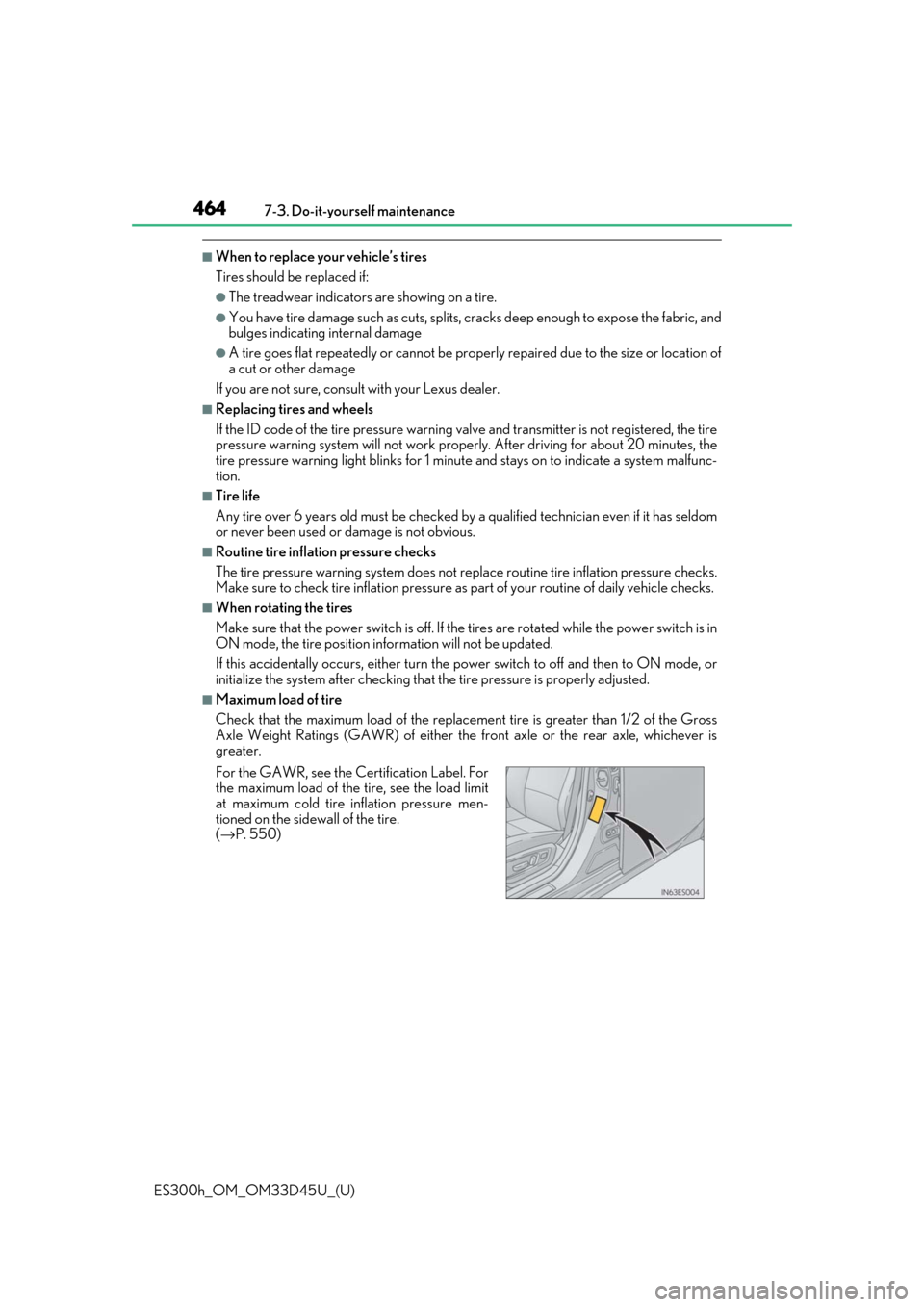
464
ES300h_OM_OM33D45U_(U)7-3. Do-it-yourself maintenance
■When to replace your vehicle’s tires
Tires should be replaced if:
●The treadwear indicators are showing on a tire.
●You have tire damage such as
cuts, splits, cracks deep enough to expose the fabric, and
bulges indicating internal damage
●A tire goes flat repeatedly or cannot be properly repaired due to the size or location of
a cut or other damage
If you are not sure, consult with your Lexus dealer.
■Replacing tires and wheels
If the ID code of the tire pressure warning valve and transmitter is not registered, the tire
pressure warning system will not work proper ly. After driving for about 20 minutes, the
tire pressure warning light blinks for 1 minu te and stays on to indicate a system malfunc-
tion.
■Tire life
Any tire over 6 years old must be checked by a qualified technician even if it has seldom
or never been used or damage is not obvious.
■Routine tire inflation pressure checks
The tire pressure warning syst em does not replace routine tire inflation pressure checks.
Make sure to check tire inflat ion pressure as part of your routine of daily vehicle checks.
■When rotating the tires
Make sure that the power switch is off. If the tires are rotated while the power switch is in
ON mode, the tire position information will not be updated.
If this accidentally occurs, either turn the power switch to off and then to ON mode, or
initialize the system after checking that the tire pressure is properly adjusted.
■Maximum load of tire
Check that the maximum load of the replacement tire is greater than 1/2 of the Gross
Axle Weight Ratings (GAWR) of either the front axle or the rear axle, whichever is
greater.
For the GAWR, see the Ce rtification Label. For
the maximum load of the tire, see the load limit
at maximum cold tire inflation pressure men-
tioned on the sidewall of the tire.
( → P. 550)
Page 473 of 608
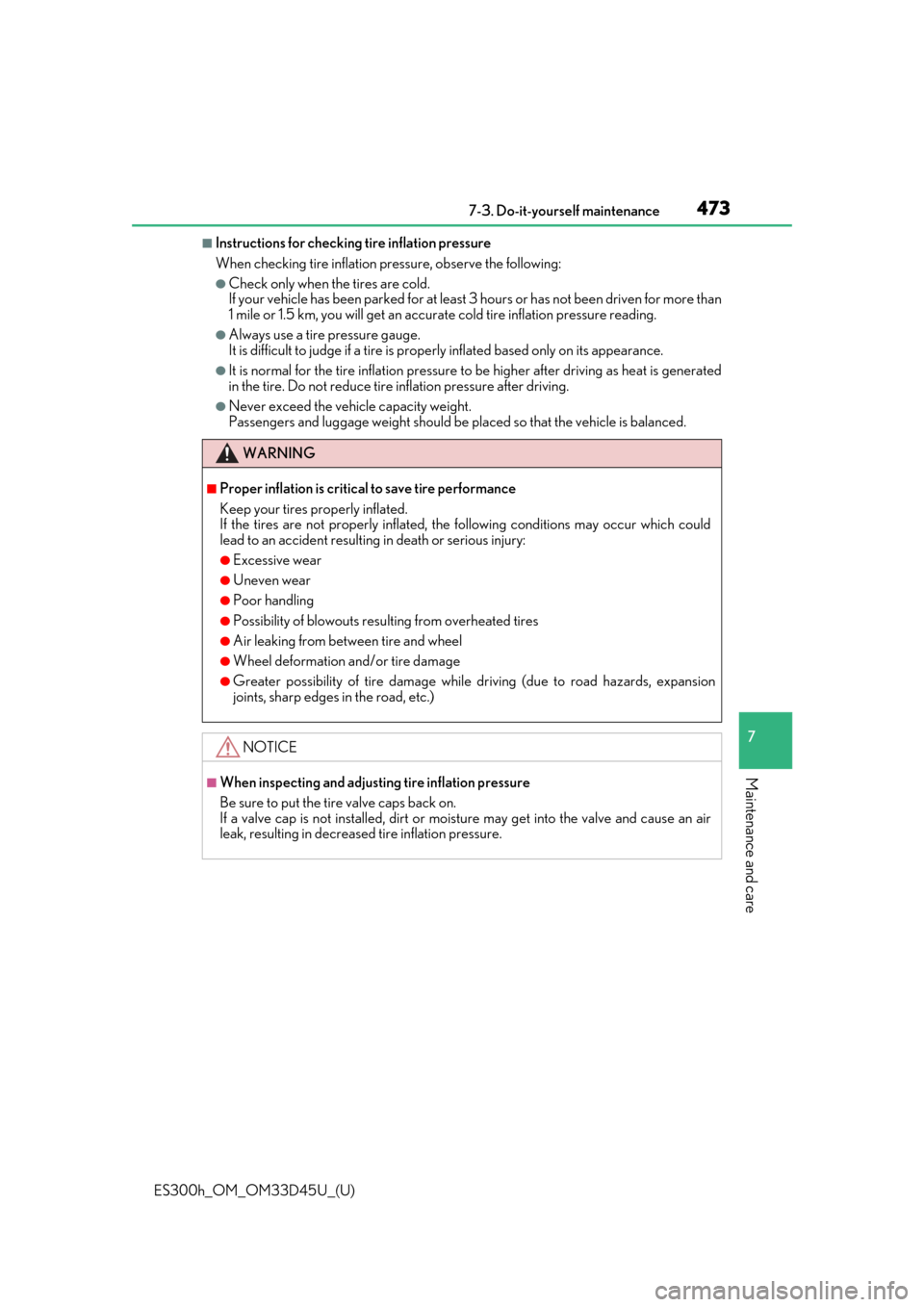
ES300h_OM_OM33D45U_(U)
4737-3. Do-it-yourself maintenance
7
Maintenance and care
■Instructions for checking tire inflation pressure
When checking tire inflation pressure, observe the following:
●Check only when the tires are cold.
If your vehicle has been parked for at least 3 hours or has not been driven for more than
1 mile or 1.5 km, you will get an accurate cold tire inflation pressure reading.
●Always use a tire pressure gauge.
It is difficult to judge if a tire is properly inflated based only on its appearance.
●It is normal for the tire inflat ion pressure to be higher after driving as heat is generated
in the tire. Do not reduce tire inflation pressure after driving.
●Never exceed the vehicle capacity weight.
Passengers and luggage weight should be placed so that the vehicle is balanced.
WARNING
■Proper inflation is critical to save tire performance
Keep your tires properly inflated.
If the tires are not properly inflated, the following conditions may occur which could
lead to an accident resulting in death or serious injury:
●Excessive wear
●Uneven wear
●Poor handling
●Possibility of blowouts resu lting from overheated tires
●Air leaking from between tire and wheel
●Wheel deformation and/or tire damage
●Greater possibility of tire damage while driving (due to road hazards, expansion
joints, sharp edges in the road, etc.)
NOTICE
■When inspecting and adjust ing tire inflation pressure
Be sure to put the tire valve caps back on.
If a valve cap is not installed, dirt or moisture may get into the valve and cause an air
leak, resulting in decreased tire inflation pressure.